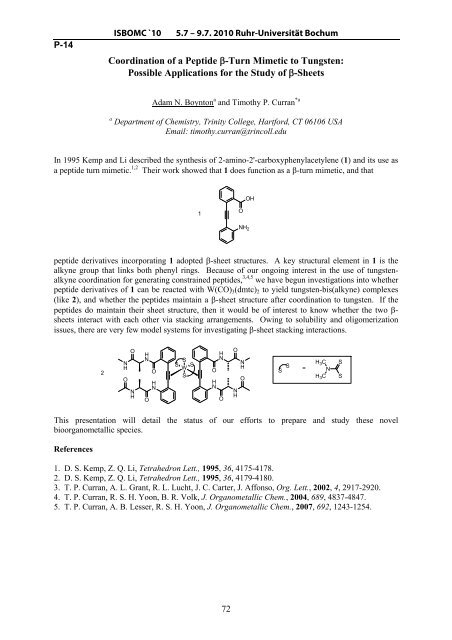Book of Abstracts - Ruhr-Universität Bochum
Book of Abstracts - Ruhr-Universität Bochum
Book of Abstracts - Ruhr-Universität Bochum
Create successful ePaper yourself
Turn your PDF publications into a flip-book with our unique Google optimized e-Paper software.
P-14<br />
ISBOMC `10 5.7 – 9.7. 2010 <strong>Ruhr</strong>-<strong>Universität</strong> <strong>Bochum</strong><br />
Coordination <strong>of</strong> a Peptide �-Turn Mimetic to Tungsten:<br />
Possible Applications for the Study <strong>of</strong> �-Sheets<br />
Adam N. Boynton a and Timothy P. Curran *a<br />
a Department <strong>of</strong> Chemistry, Trinity College, Hartford, CT 06106 USA<br />
Email: timothy.curran@trincoll.edu<br />
In 1995 Kemp and Li described the synthesis <strong>of</strong> 2-amino-2'-carboxyphenylacetylene (1) and its use as<br />
a peptide turn mimetic. 1,2 Their work showed that 1 does function as a �-turn mimetic, and that<br />
1<br />
peptide derivatives incorporating 1 adopted �-sheet structures. A key structural element in 1 is the<br />
alkyne group that links both phenyl rings. Because <strong>of</strong> our ongoing interest in the use <strong>of</strong> tungstenalkyne<br />
coordination for generating constrained peptides, 3,4,5 we have begun investigations into whether<br />
peptide derivatives <strong>of</strong> 1 can be reacted with W(CO)3(dmtc)2 to yield tungsten-bis(alkyne) complexes<br />
(like 2), and whether the peptides maintain a �-sheet structure after coordination to tungsten. If the<br />
peptides do maintain their sheet structure, then it would be <strong>of</strong> interest to know whether the two �sheets<br />
interact with each other via stacking arrangements. Owing to solubility and oligomerization<br />
issues, there are very few model systems for investigating �-sheet stacking interactions.<br />
2<br />
N<br />
H<br />
O<br />
O<br />
N<br />
H<br />
H<br />
N<br />
O<br />
O<br />
H<br />
N<br />
S<br />
S S<br />
W<br />
S<br />
O<br />
H<br />
N<br />
H<br />
N<br />
O<br />
72<br />
O<br />
N<br />
H<br />
O<br />
NH 2<br />
N<br />
H<br />
O<br />
OH<br />
S S<br />
=<br />
H3C S<br />
N<br />
H3C S<br />
This presentation will detail the status <strong>of</strong> our efforts to prepare and study these novel<br />
bioorganometallic species.<br />
References<br />
1. D. S. Kemp, Z. Q. Li, Tetrahedron Lett., 1995, 36, 4175-4178.<br />
2. D. S. Kemp, Z. Q. Li, Tetrahedron Lett., 1995, 36, 4179-4180.<br />
3. T. P. Curran, A. L. Grant, R. L. Lucht, J. C. Carter, J. Affonso, Org. Lett., 2002, 4, 2917-2920.<br />
4. T. P. Curran, R. S. H. Yoon, B. R. Volk, J. Organometallic Chem., 2004, 689, 4837-4847.<br />
5. T. P. Curran, A. B. Lesser, R. S. H. Yoon, J. Organometallic Chem., 2007, 692, 1243-1254.
















